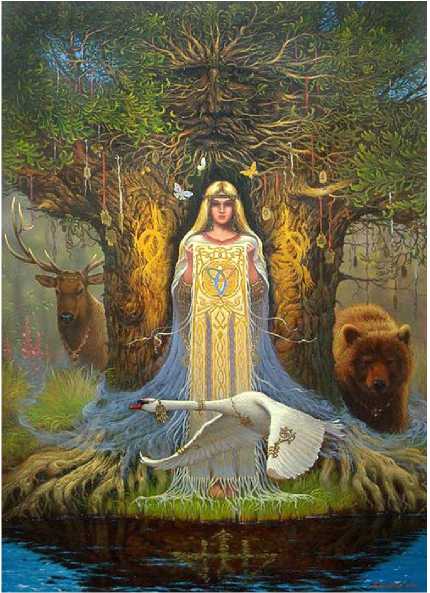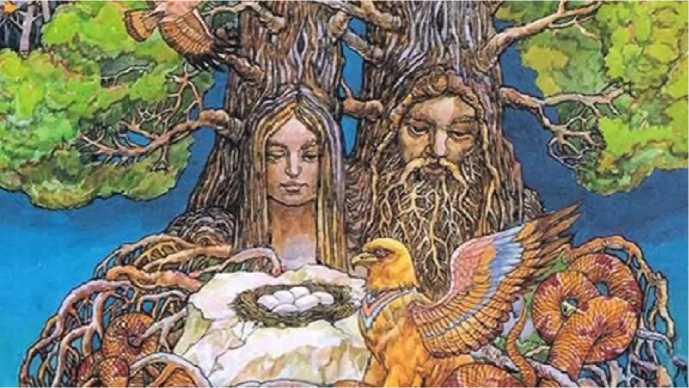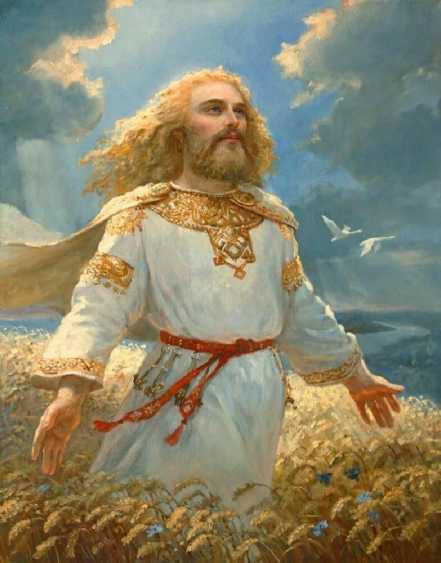Mythology in the ancient written texts of the slavs
Автор: Getmantsev Sergei Mikhailovich
Журнал: Bulletin Social-Economic and Humanitarian Research @bulletensocial
Статья в выпуске: 8 (10), 2020 года.
Бесплатный доступ
The problems of this article may be of some interest to modern Orthodoxy, which has recently been concerned about the surge of neo-paganism, which is expressed in the rejection of traditional Christian values and norms of behavior and seeks to replace them with other worldview positions. The history of the study of East Slavic paganism dates back at least three centuries. The methods of studying the mythological representations of the ancient Slavs changed and became more complex. Such research was based on an increasingly solid methodological basis, and the works of scientists of the XVIII-XIX centuries were replaced by more complex and formalized monographs of specialists from an even wider range of Sciences who considered Slavic paganism from narrow professional positions. Based on the results obtained, it is assumed that the existence of the ancient Russian Khors cult is compared with Dazhdbog and this pair of deities, in turn, is compared with the ancient Indian Ashwins, who are the most striking example of Indo-European twin deities associated with the solar cult known to science at the moment.
Religion, cult, society, country, faith
Короткий адрес: https://sciup.org/14118419
IDR: 14118419 | DOI: 10.5281/zenodo.4247526
Текст научной статьи Mythology in the ancient written texts of the slavs
The topic of East Slavic paganism has become very popular in recent years. Now there is a mass of scientific, popular science, fiction, one way or another connected with East Slavic paganism and Slavic mythology. Scientific interest in this topic, which originated in our country back in the 17th century. (if we count from the "Synopsis" by Innokenty Gisel), since then it has never completely faded away despite the changing conjuncture, breaking through the burden of pre-revolutionary spiritual censorship and disregarding the general decline in interest in religious issues during the years of Soviet power. General cultural interest in this area has also always been high, because, without having an idea of ancient Russian paganism, it is difficult to understand ancient Russian monuments of literature and art, Russian folk art in its various manifestations (embroidery, woodcarving, games, songs, etc.). A striking example, confirming this statement, can serve at least the famous "Lay of Igor's Host", thoroughly permeated with pagan motives and gave rise to an immense amount of literature.
II. METHODOLOGY
In accordance with the specifics of this study, carried out at the junction of several scientific disciplines -religious studies, philosophy, history, ethnography - the concepts of scientists of various specialties are used as a theoretical and methodological basis for the study. At the same time, the author of this work was greatly influenced by the works of Russian researchers, united to one degree or another by their interest in semiotic problems. Among them are such names as: V.Ya. Propp, M.M. Bakhtin, B.A. Uspensky. Taking into account the importance for this work of some of the historical aspects of the problems touched upon, for its author a significant principle is the implementation of a cultural-semiotic approach to history. This approach "presupposes an appeal to the internal point of view of the participants in the historical process: what is significant from their point of view is recognized as significant."
The interpretation of the specifics of the Old Russian solar deities proposed in this work can help to take a fresh look at the entire system of Old Russian (and, more broadly, East Slavic) paganism. There is no need to come up with various sophisticated reasons for introducing two solar deities into the pantheon of Prince Vladimir, including explaining this fact by the influences of other ethnic groups, while postulating complex ethnic and social processes in ancient Russian society. In addition, the proposed version can explain the absence of such a prominent deity as Volos in the chronicle pantheon of Prince Vladimir.
III. DISCUSSION AND RESULTS
In order to determine the specifics of the use of this concept in modern (mainly domestic) scientific discourse, this work examines the most notable and fundamental works of domestic and foreign researchers (philosophers, philologists, historians, folklorists, religious scholars) devoted to this issue. These authors include such names as: S. A. Tokarev, V. Ya. Propp, A. F. Losev, Ya. E. Golosovker, F. H. Cassidy, M. I. Steblin-Kamensky, I. M. Diakonov, O. M. Freudenberg, M. Eliade, K. Levi-Strauss, K. Huebner, and others. When selecting the analyzed literature, priority was given not only to the works of the most famous theorists in this field, but also to the works of practical scientists who directly worked with the remnants of ancient mythological representations in the popular environment or studied ancient mythologies based on authentic primary sources.
An order of magnitude greater number of scientific publications are devoted to the consideration of issues related to East Slavic mythology. From the goals and objectives of this work, it was necessary to analyze first of all those works that reveal the essence of the deities of the old Russian Pantheon, traditionally considered solar-Horsa and Dazhbog (first of all, Horsa - as deities whose functional mythological characteristics and ethnicity are most controversial).
As for the question of the essence of the God Horsa, a good overview of the historiography of the problem was made in the monograph of M. A. Vasiliev. In our study, we additionally identified and analyzed the history of the formation and consolidation of the scientific tradition that connects this deity with the solar cult on the basis of its etymology, presumably ascended to the Iranian roots. This version, first expressed by P. G. Butkov in 1821, was soon repeated by such prominent Slavists as P. I. Preis, I. I. Sreznevsky, and O. M. bodyansky. Then it becomes a common place for most publications devoted to the old Russian Pantheon, in the XIX century it is repeated by N. I. Kostomarov, I. E. Zabelin and some others, then it smoothly passes into the next century - we find it in the works of F. E. Korsh, E. G. Kagarov.
At the moment, there is some stagnation in the study of East Slavic paganism, due to the uncertainty of the initial methodological prerequisites. The study of East Slavic paganism is conducted by scientists of various specialties, using methods typical of various scientific disciplines, but there is no organic and timely merging of the results into a single whole. This has a negative impact on the effectiveness of research in this area.
Religious studies can and should take on the task of combining the achievements of scientists of various specialties in the study of East Slavic paganism. In addition to the mechanical integration of all available achievements, religious studies should also provide researchers with a methodological basis that is adequate to their tasks.
Despite the universal nature of the perception of the size of objects and phenomena of the surrounding world and the great similarity of the systems of object-marked standards of size among different peoples, a large role in the formation of these systems is played by national-specific features of a particular culture as a whole, specific features of everyday life, historical traditions, etc. Features of the culture and history of the people are comprehended, enter the world of thought of the people, and then, already receiving language expression, are included in the semantic space of the language of the people.
Both the Russian and English fields are allocated an equal number of parcels. However, the content of parcels in the two languages is different. The core occupancy rate in the English field is slightly higher, which is explained by the presence of synonyms: big/large; little/small. On the extreme periphery of the parcels “over rules” and “less rules” in the English field there is a greater number of adjectives formed from names of animals, such as mammoths, elephants, as well as from the names of literary characters – the dwarves, mythical beings, like elves, Cyclops, Titans, Hercules, Colossus, and the name of the group undersized Negroid peoples living in the Equatorial forests of Africa, the pygmies. Apparently, the English have a more developed idea of such creatures due to the peculiarities of cultural contacts.

In order to optimize research activities in the field of studying East Slavic paganism, it is necessary, first of all, to determine the understanding of the nature of this phenomenon. Since East Slavic paganism is a religious and mythological system, an in-depth study of the specifics of such systems is required in order to develop the most promising research directions and corresponding research methods.

For religious studies analysis of the actual religious component of East Slavic paganism, the greatest interest at the moment is the study of the religious identity of the East Slavic socio-cultural community. But, as shown in this paper, there is very little material for such research, so such tasks now seem impossible. In this regard, special attention should be paid to the study of the mythological component of East Slavic paganism. At the same time, it is necessary to clarify the meaning of the term "mythology", since in modern religious discourse it is understood ambiguously.

As a result of the review of the prevailing theories of myth in Russian science, the author's understanding of such a phenomenon as mythology was formulated. Mythology is the only possible primitive (archaic) worldview that reflects the reality directly given to man by its verbal description through tropes and does not distinguish between the natural and the supernatural, faith and knowledge. Since the Eastern Slavs of the period of existence in their environment of paganism were at a much higher stage of development than those human communities in which mythology was born, there is no reason to say that mythology was the only form of worldview available to them. However, there is no doubt that there are numerous relics of mythological thinking in their minds. In order to specify the subject of the study, it is proposed to divide the concept of mythology into two parts, and in this connection, such concepts as archaic mythology and modern mythology are introduced.
IV. CONCLUSION
At that stage of human development, when archaic mythology was the only form of understanding of the world, almost any extended utterance that required the use of abstract concepts inevitably had to take the form of a myth, i.e. a statement in which the General is transmitted through the particular. Archaic myths are the material that makes up the myths that are called complex, secondary, or recent in this work and belong to the second group of myths. These are exactly the myths that are meant by this word in everyday, everyday language. An example of this type of myth is the well-known ancient Greek myths.
Список литературы Mythology in the ancient written texts of the slavs
- Abaev V. I. (1965) Scythian-European isoglosses. At the junction of East and West. M.: Science. 168 p. (in Russ).
- Balushok V. G. (1993) Initiations of the ancient Slavs (reconstruction attempt). Ethnographic review, №. 4. Pp. 57-66. (in Russ).
- Bogdanovich A. E. (1895) Remnants of the ancient worldview of the Belarusians. The ethnographic collection. Grodno. 186 p. (in Russ).
- Danilevsky I. N. (2001) Ancient Russia through the eyes of contemporaries and descendants (IX-XII centuries): Moscow: Aspect-Press. 339 p. (in Russ).
- Ershov B.A. (2010) The Russian Orthodox Church and secular power in the Voronezh province in the XIX - early XX centuries. GOU VPO "Voronezh State Technical University". Voronezh. 167 p. (in Russ).
- Ershov B.A. (2010) The system of spiritual education in Voronezh province in the 19th century. Education and Society. №. 5 (64). Pp. 105-108. (in Russ).
- Ershov B.A., Fursov V.N. (2018) The Russian Church in the State Mechanism of Russia. Bulletin Social- Economic and Humanitarian Research. № 1. Pp. 32-37. (in Engl).
- Ershov B.A., Krylov N.V., Stepanenko I.S. (2017) Interaction of the Russian Orthodox Church and civil society in modern Russia. International Journal of the Humanities and Natural Sciences. № 1. Pp. 30-31. (in Russ.)
- Ershov B.A., Perepelitsyn A., Glazkov E., Volkov I., Volkov S. (2019) Church and State in Russia: management issues. In the collection: 5th INTERNATIONAL CONFERENCE ON ADVENCES IN EDUCATION AND SOCIAL SCIENCES. Abstracts & Proceedings, e-publication. Pp. 26 - 29. (in Engl).
- Galkovsky N. M. (1916) the Struggle of Christianity with the remnants of paganism in ancient Russia.: Diocesan printing house. 388 p. (in Russ).
- Kagarov E. G. (1918) Religion of the ancient Slavs. Cultural and community essays on the history of the world. Russian history. №. 4. Pp. 3-73. (in Russ).
- Krasnikov A. N. (2004) Methodology of classical religious studies. Blagoveshchensk: Library of the journal "religious Studies". 148 p. (in Russ).
- Losev A. F. (1991) Dialectics of myth. Philosophy. Mythology. Culture. Moscow: Politizdat. P. 22 - 187. (in Russ).
- Mansikka V. Y. (2005) Religion of the Eastern Slavs. M.: imli im. A. M. Gorky RAS. 368 p. (in Russ).
- Martynov B. B. (1989) Sacred world "Words about Igor's regiment". Slavic and Balkan folklore. Reconstruction of the Slavic spiritual culture: sources and methods. Moscow: Nauka. Pp. 61 - 78. (in Russ).
- Pavlenko V. N. (2000) Ideas about the relationship between social and personal identity in modern Western psychology. Voprosy psihologii. №. 1. Pp. 135-141. (in Russ).
- Perevozchikova L.S., Ershov B.A., Volkova E.A., Frolova E.V. (2017) Russian Orthodox Church in views of F.M. Dostoevsky in XIX century. In the collection: The European Proceedings of Social & Behavioral Sciences. Pp. 319 - 323. (in Engl).
- Rybakov B. A. (2001) Paganism Of Ancient Russia. M.: Sofia. 744 p. (in Russ).
- Sabinin S. (1847) On a Prologue of the library of the Moscow Spiritual printing House and on the identity of the Slavic deities, Horsa and dazhdbog. CHIDR. №. 9. Ed. IV. Pp. 22-23. (in Russ).
- Shkarubo S. N. (2018) History of the political press of post-Soviet Russia: in the book: society, science, education: trends and prospects of development. collective monograph on the results of a scientific and practical conference with international participation. Pp. 354-357. (in Russ).
- Shkarubo S. N. (2019) Features of the development of the scientific and industrial potential of the USSR during the great Patriotic War. Bulletin Social-Economic and Humanitarian Research. №. 3 (5). Pp. 73-81. (in Russ).
- Shkarubo S. N. (2019) The main directions in the policy of Nicholas I to solve the peasant question: historiography of the problem. Modern science: actual problems of theory and practice. Series: Humanitarian Sciences. №. 1. Pp. 48-51. (in Russ).
- Shkarubo S.N. (2018) The historical significance and the main results of the NEP in the USSR. Modern Science: Actual Problems of Theory and Practice. Series: Humanities. №. 1. Pp. 47-50.(in Russ)
- Tokarev S. A. (1957) Religious views of the East Slavic peoples of the XIX-early XX centuries. L. 164 p. (in Russ).
- Zaliznyak A. A. (1962) Problems of Slavic-Iranian language relations of the most ancient period. Questions of Slavic linguistics: collection of articles. Vol. 6. Moscow: Publishing house of the USSR Academy of Sciences. Pp. 28-45. (in Russ).


